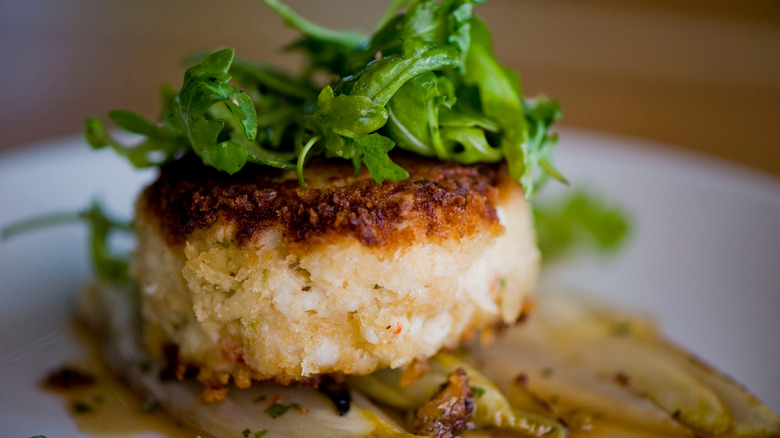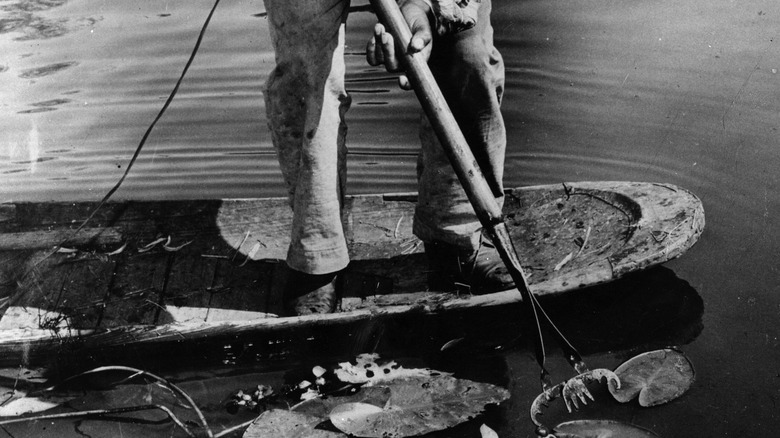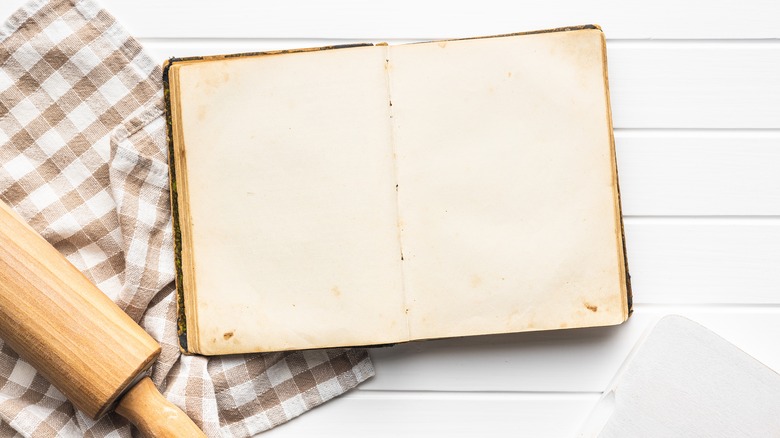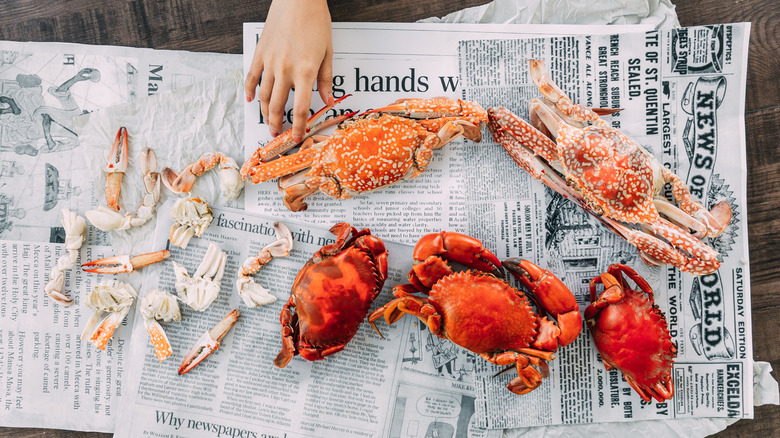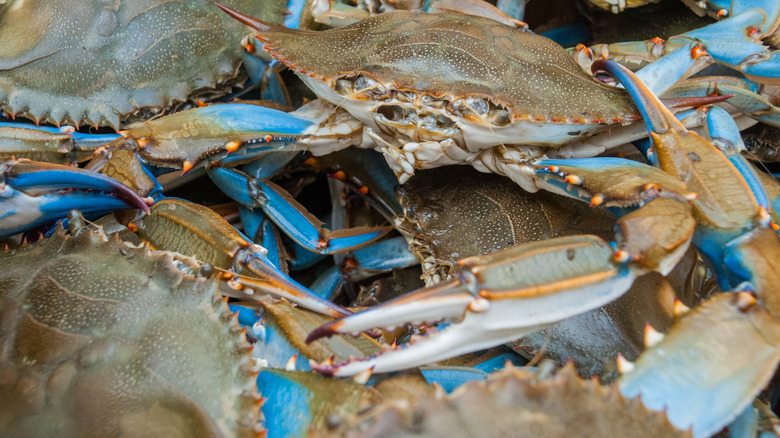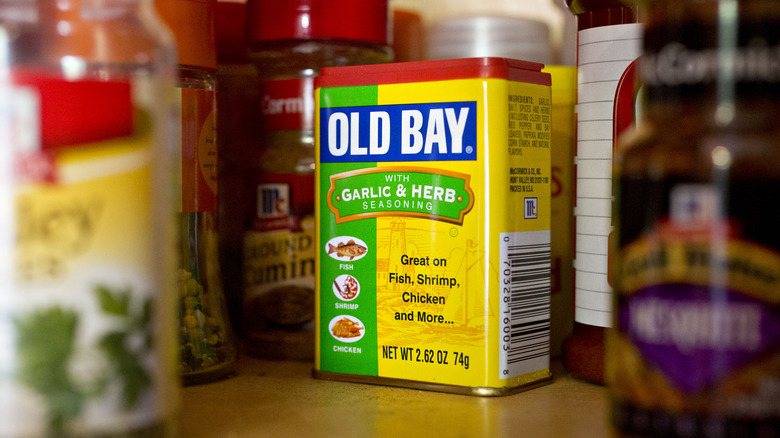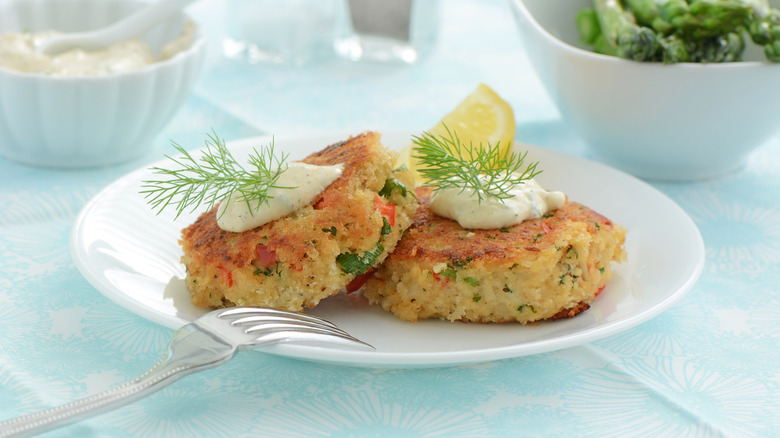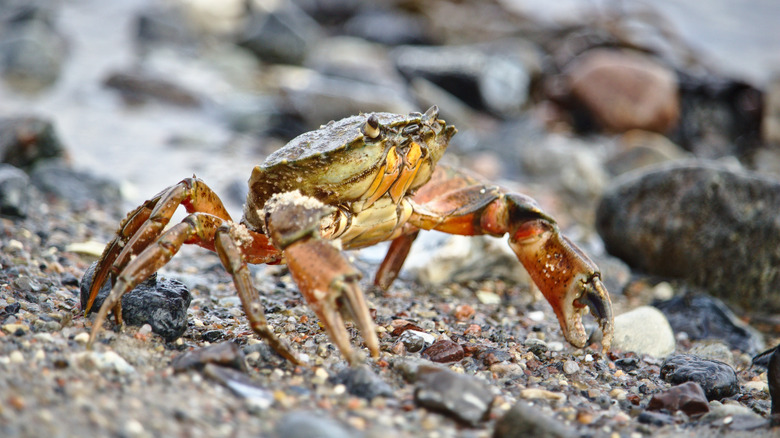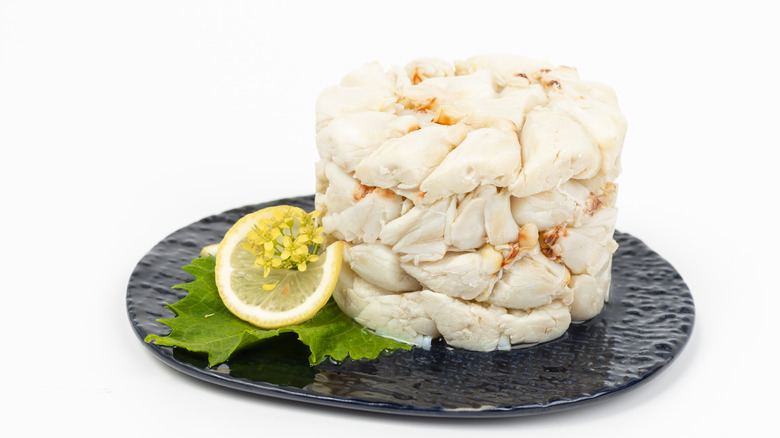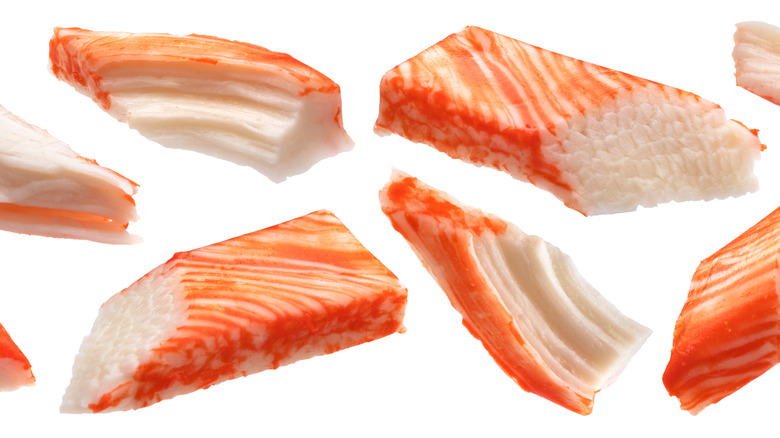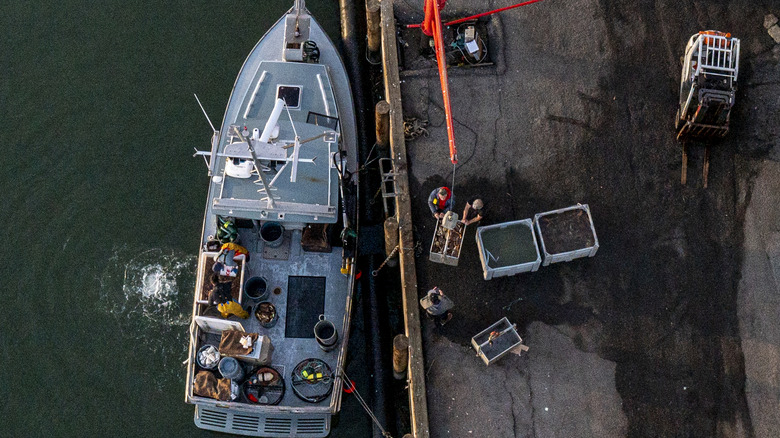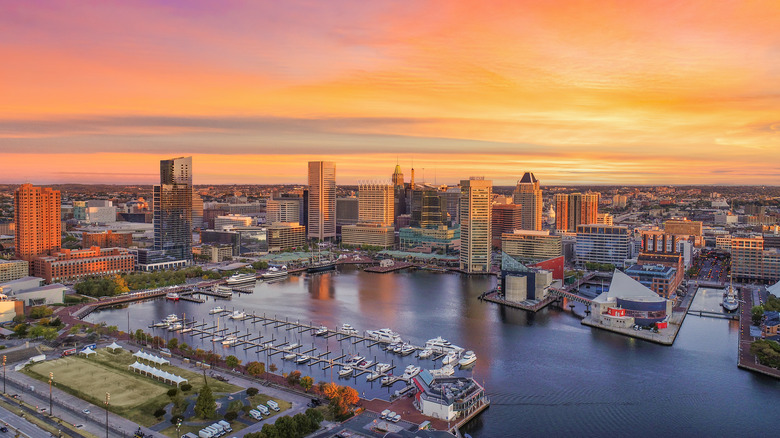The Untold Truth Of Crab Cakes
From 16th-century indigenous tribes to modern-day celebrities like Oprah Winfrey, crab cakes are one of the oldest, most popular dishes in American history. According to Southern Maryland This is Living Magazine, Maryland alone harvests millions of pounds of blue crab every year. When it comes to coastal cuisine, none is perhaps more synonymous with the state as crab cakes, inspiring coastal states across the country to adopt their own versions.
Typically made with a blend of spices –- most commonly Old Bay seasoning –- peppers, onions, and a binder like eggs, mayonnaise, or bread crumbs, topped with a crunchy slaw and a cream-based sauce, crab cakes are a staple dish at restaurants all over the U.S., and for good reason: They're a crowd pleaser. Just ask Al Roker or Oprah Winfrey, who have both expressed their love for this deep-sea delicacy.
While crab cake fans might all agree on their popularity and palatable appeal, various facts are unknown to even the most devoted aficionados. We've rounded up a list of untold truths to explore the depths of this culinary treat.
Cakes of crab were created by Native Americans in the Chesapeake Bay
The origin of crab cakes is believed to date back to Native Americans in the Chesapeake Bay region, who first created cakes of crab using crab meat, cornmeal, vegetables, and bear fat (via The Baltimore Sun). Although evidence that indigenous people caught and consumed crab has been widely speculated, it was confirmed by a team of scientists studying archeological remains in the Chesapeake Bay, according to the Smithsonian Insider.
Further research compiled by McGill University indicates that indigenous women collected crabs at low tide while men hunted them with spears from canoes. Other studies show that tribes in North America created what is now known as the crab pot by dropping a wire cage in the water to gather and retrieve crabs. Sources across the board seem to conclude that crab meat was difficult to preserve before the creation of refrigerators, so crab cakes would likely have been considered a delicacy among Native American tribes.
The first recipe for crab cakes was published in 1891
According to Baltimore Magazine, some historians believe the first recipe for crab cakes appeared in "New York's World's Fair Cookbook," written in 1939 by Crosby Gaige, president of the New York Wine & Food Society. However, the first published reference to crab cakes after European colonization in the United States was made by Thomas J. Murrey, a professional hotel caterer turned cookbook author, in his 1891 cookbook "Cookery with a Chafing Dish."
A chafing dish resembles a frying pan that sits atop a flame, and Murrey used the technique to cook numerous types of seafood dishes including deviled oysters, scallop curry, frog leg patties, lobster pomodoro, and the first-ever crab cake recipe in print. Murrey advises readers to boil hard-shell crab meat, season it, and mix it with egg yolk before forming it into cakes. The patties are sauteed in a chafing dish with oil or butter — a cooking technique that is still commonly performed in restaurants today.
Refrigerated trains made crab meat available across the US
Although William Davis invented refrigerated railroad cars in the late 1800s (per Detroit Historical Society), they were not readily available until the 1930s. At this point, crab meat began its journey from waterways and crab pots in the Chesapeake Bay to kitchens and restaurants across the United States. This historical time period also helped establish Maryland as the dominant source of crabs above any other coastal state.
Designed first and foremost for shipping fruits, the University of Irvine Humanities Center reports that refrigerated trains evolved such that by 1939, they were being used to transport crab meat from the Chesapeake Bay region. The demand for fresh crab grew with the publication of Crosby Gaige's "New York's World's Fair Cookbook," which widely popularized crab cakes thanks to his renowned recipe.
With technological advancements in crab harvesting combined with increased distribution of crab meat due to refrigerated railroad cars, crab cakes became a staple dish in popular restaurants from coast to coast, eventually making it to the international scale as well.
There are rules for removing crab meat
Removing crab meat from the shells by hand follows the same process today as it has since Thomas J. Murrey instructed readers in his cookbook "Cookery with a Chafing Dish." There are indeed specific rules and techniques for extracting crab meat, and Murrey emphasizes: "Remove the skin carefully without breaking the flesh."
As is outlined in Visit Baltimore, extracting the delicate meat from crab is a time-honored tradition that requires patience and practice, as it is not easy to remove it all from the crustacean's nooks and crannies. The first step is to prepare your surface with a table cloth or layers of newspaper because picking crab meat is a messy process.
Other suggested tools and utensils include a mallet, nut or shell crackers, and a couple of bowls to separate the meat from the shells. Next, start by splitting the crab legs from the body, opening the body cavity, and removing the lungs. Although the lungs are not toxic, they generally do not taste appetizing and should be discarded. Lastly, carefully remove the meat from the legs and claws, where you'll usually find the sweetest and largest pieces.
You can't call it a Maryland crab cake if you don't use blue crab
According to Southern Maryland This is Living Magazine, there are numerous cooking techniques, ingredients, and technical details that go into defining what is or isn't an authentic Maryland crab cake. Some people believe that in order to be called a Maryland crab cake, the diner must be eating the dish in the state of Maryland. Other chefs and crab cake connoisseurs assert that Old Bay Spice is a necessary ingredient to be classified as a Maryland crab cake. Another defining factor is the use of onions and green peppers as essential ingredients. However, the ultimate test of whether or not a Maryland crab cake is truly original and worthy of its title is whether it's made with blue crab.
Scientifically referred to as Callinectes sapidus, which means beautiful savory swimmer, the National Oceanic and Atmospheric Administration reports that the Maryland blue crab is considered to be the most valuable seafood caught in the Chesapeake Bay. The millions of pounds harvested each year are distributed across Maryland as well as all over the U.S. Due to their nationwide demand, blue crabs are the only type of Chesapeake Bay fish whose population is analyzed and tracked on a yearly basis.
Crab cakes are synonymous with Old Bay spice
Perhaps it's a historical coincidence or maybe it was destined to be fate, but either way, the creation of Old Bay seasoning in 1939 occurred at the exact same time crab cakes were popularized (via The Culture Trip). Invented by German refugee Gustav Brunn who arrived on the shores of the Chesapeake Bay in 1939, the famous seasoning consists of 18 herbs and spices, including celery salt, pepper, mustard, paprika, pimento, and cloves.
Unfortunately, the vague nature of Old Bay's ingredient label which simply lists the general word spices leaves those attempting to replicate the blend at a loss. Old Bay is considered a required ingredient in Maryland-based crab cake recipes and it is still produced in Baltimore to this day. However, the savory mix is now manufactured by McCormick & Company, which purchased the rights to distribute the spice in 1990.
Crab cake recipes have been recreated across the country
Recipes for crab cakes have been duplicated across the United States and even around the world, reflecting flavors and ingredients distinct to the regions. From authentic Maryland-style cakes featuring Old Bay spice to west coast Dungeness crab cakes with assorted toppings, there is no lack of flavor. In the Northeastern states, and specifically in Baltimore, crab cakes are typically bonded together with a thick creamy mayonnaise-based sauce, as evidenced by Andrew Zimmern's rendition.
According to Southern Living, cornbread crumbs are commonly used as a binder in the South. Meanwhile, on the West Coast, recipes are more adventurous and often feature breadcrumbs or crackers as the binding agents (via Pure Food Fish Market). Whether using Dungeness crab, Maryland blue crab, or Alabama jumbo crab meat, recipes nationwide tend to highlight a mixture of herbs, spices, vegetables, and sauces to make each individual take on crab cakes stand out.
There are over 4,000 species of crab
Although Crab-O-Licious reports that there are more than 4,000 different types of crab found in bodies of water around the world, less than a dozen are actually edible. Scientists at American Oceans believe crabs have existed since the Jurassic period over 200 million years ago. These crustaceans are among the most popular seafood consumed globally, in particular blue crabs. Meanwhile, king crabs are the largest, weighing in at over 10 pounds. They are also the most commonly caught species of crab and were featured on the Discovery Channel's popular reality television fishing show, "The Deadliest Catch," which takes place near Alaska and the Aleutian Islands.
Rock crab, snow crab, queen crab, and spider crab all refer to the same species, which is identifiable by its long spider-like legs and is found in the coastal waters of the eastern United States, as well as in parts of the North Pacific. Among the edible species, Dungeness crabs are another common base for crab cake recipes, particularly along the West Coast as they are often caught off the shores of Alaska, California, and Baja, Mexico.
Crab meat is considered highly nutritious
Crab meat -– no matter the species, so long as it is edible -– is considerably high in vitamin B12, which promotes healthy blood and cellular function (via National Institute of Health). In fact, per the USDA, a 3-ounce serving of crab accounts for more than three times the FDA recommendations for B12. Crab meat is also low in fat, high in protein, and doesn't contain any carbohydrates, making it a suitable component of a healthy diet. As the largest consumers and importers of crab, the American population gets to reap the benefits of this flavorful protein (via WebMD).
The crustacean also contains high levels of minerals and nutrients like sodium, zinc, copper, and selenium, as well as omega-3 fatty acids, which are regarded for their anti-inflammatory properties (via Harvard Health). Additionally, crab contains some of the lowest concentrations of mercury when compared to other types of seafood, according to an analysis by the FDA.
Crab cakes can be made with imitation crab
Although there are over 4,000 species of crab on the planet, there's an imposter on the market that is widely consumed. Imitation crab mimics the texture and flavor of real crab, although it does not contain any meat from the crustacean at all. It is still mostly made up of seafood ingredients, though they come in the form of surimi, or fish paste made from pollock (via Healthline).
According to The Daily Meal, imitation crab was invented by the Japanese in the 1970s. Although it is processed, it is still safe to consume and offers a budget-friendly longer shelf-life alternative to the real deal. Sometimes referred to as seafood, crab stick, or simply krab, imitation crab is most widely used in grocery store sushi, take-out Chinese food, and in pre-packaged salads. While it doesn't measure up to the genuine stuff, imitation crab may be a more accessible alternative if you're in a pinch.
A man was sued for nearly $1 million in an illegal crab fishing case
In May 2022, the Associated Press reported that a San Francisco man was sued for $1 million in an illegal crabbing case that was referred to as the most serious case of its kind in local history. The lawsuit also refers to the case as being the worst instance of illegal crabbing in any marine-protected area in the state. According to the Los Angeles Times, the San Francisco District Attorney's office charged pricey fines against licensed commercial fisherman Tam Van Tran for attempting to remove a marine source from one of the most protected bodies of water in the state.
After receiving an anonymous tip from a commercial fisherman, investigators with the California Department of Fish and Wildlife discovered over 90 crab traps containing more than 250 Dungeness crabs. They were scattered around an ecologically protected marine reserve at the Farallon Islands, which is nearly 30 miles off the coast of San Francisco.
Al Roker and Oprah Winfrey are obsessed with Baltimore crab cakes
In a special segment of his all-day series "Family Style" for Today, Al Roker treats viewers to a tour of Baltimore's best-known crab cake establishments. In the 24-minute clip, Roker explores the connection between crab cakes and Baltimore's history, community, and culture. Starting with the famous Faidley's Seafood restaurant, Roker's culinary tour dives into the history of crab fishing in the Chesapeake Bay. The episode wraps up with a ravishing review of a modern-day twist on Baltimore's culinary past, with the newly famous crab cake egg rolls at Papi Cuisine.
It's hard to say whether or not Oprah Winfrey caught Roker's special segment on Baltimore crab cakes, but what we know for sure is that Winfrey loves crab cakes so much that she has had them delivered from Maryland, according to an Instagram post on her account. As a former Baltimore resident, the television talk show host and world-renowned entrepreneur is a huge fan of Pappas award-winning crab cakes, as well as the popular Costas Inn, which her long-time partner Stedman Graham also loves (via Oprah Daily).
